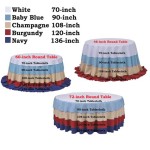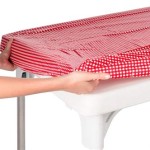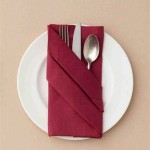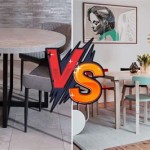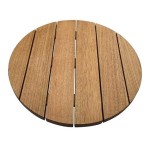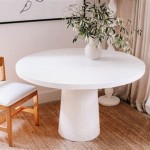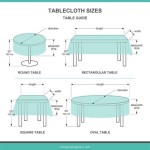How to Decorate Wedding Reception Tables
Wedding reception table decorations are a crucial element in setting the overall ambiance and aesthetic of the celebration. Thoughtful and cohesive decorations can transform a simple venue into a personalized and memorable space for the wedding couple and their guests. The selection of decorations should consider the wedding's theme, color palette, and desired level of formality. Effective table decoration involves a combination of centerpieces, linens, tableware, and smaller decorative accents that complement the larger venue design.
Planning the table decor should begin well in advance of the wedding day. This allows ample time for sourcing materials, finalizing design choices, and coordinating with vendors such as florists, linen rental companies, and event planners. A detailed budget should also be established to ensure that all decorations align with the overall financial plan for the wedding.
Choosing the Right Centerpieces
Centerpieces are the focal point of each reception table and have a significant impact on the overall visual impression. The style of the centerpiece should reflect the wedding's theme, whether it is classic and elegant, rustic and natural, modern and minimalist, or something else entirely. Consideration must be given to the size and height of the centerpieces to avoid obstructing guests' views across the table and inhibiting conversation. A general rule of thumb is to keep centerpieces either below eye level (approximately 12 inches) or significantly above eye level to allow for unobstructed sightlines.
Floral arrangements are a popular choice for centerpieces. The selection of flowers should align with the wedding's color scheme and style. Options range from traditional roses and lilies to more exotic orchids and tropical flowers. The container holding the flowers is also an important element. Vases, bowls, urns, and repurposed containers can all be used to create different looks. For a rustic wedding, wooden boxes or mason jars might be suitable, while a modern wedding could feature sleek glass vases or geometric metal structures.
Non-floral centerpieces offer alternative options for creating visually appealing table decorations. Candles, either alone or in combination with other decorative elements, can add warmth and romantic ambiance. Floating candles in glass bowls, pillar candles in varying heights, or candelabras can all be used to create different effects. When using candles, safety should be a primary concern. Ensure that candles are placed in stable holders and are kept away from flammable materials. Consider using flameless LED candles as a safe and practical alternative, especially in venues with restrictions on open flames.
Other non-floral centerpiece options include collections of objects that reflect the wedding couple's interests or hobbies. Books, vintage items, shells, or even small sculptures can be used to create unique and personalized centerpieces. The key is to curate a collection of items that are visually appealing and cohesive with the overall wedding theme. For example, a travel-themed wedding could feature miniature globes, vintage suitcases, and maps as part of the centerpiece design.
The number of centerpieces per table will depend on the size and shape of the table. A single, large centerpiece may be sufficient for a smaller table, while larger round tables may require multiple smaller centerpieces to create a balanced and visually interesting arrangement. When using multiple centerpieces, it is important to ensure that they are evenly spaced and proportional to the table size.
Selecting Linens and Tableware
Linens, including tablecloths and napkins, provide the foundation for the table decor. The choice of linens can significantly impact the overall aesthetic of the reception. Tablecloths are available in a variety of fabrics, colors, and textures. The fabric should be chosen based on the formality of the wedding and the desired level of elegance. Linen and cotton are popular choices for formal weddings, while burlap or other natural fabrics can be used for rustic or bohemian weddings. The color of the tablecloth should complement the wedding's color scheme and the other table decorations. A neutral tablecloth, such as white or ivory, provides a versatile backdrop for more colorful centerpieces and tableware.
Napkins offer another opportunity to add color and texture to the table setting. Napkins can be folded in a variety of ways to enhance the visual appeal. Simple folds, such as a basic rectangle or triangle, are suitable for more casual weddings, while more elaborate folds, such as a pocket fold or a fan fold, can be used for formal weddings. Napkin rings can also be used to add a touch of elegance or personality to the table setting. Napkin rings are available in a variety of materials, including metal, wood, and fabric.
Tableware, including plates, cutlery, and glassware, should be chosen to complement the linens and centerpieces. The style of the tableware should reflect the formality of the wedding. Fine china and crystal glassware are suitable for formal weddings, while simpler stoneware and glass can be used for more casual weddings. The color of the tableware should also be considered. White or ivory plates are a classic choice that pairs well with a variety of linens and centerpieces. Metallic accents, such as gold or silver cutlery, can add a touch of elegance to the table setting.
The placement of tableware is also an important aspect of table decoration. The standard placement of cutlery includes the fork to the left of the plate, the knife to the right of the plate, and the spoon to the right of the knife. The water glass is typically placed above the knife, and the wine glass is placed to the right of the water glass. The placement of tableware should be neat and consistent across all tables.
Charger plates, also known as service plates, are decorative plates that are placed beneath the dinner plate. They add a layer of elegance to the table setting and can be used to enhance the overall aesthetic. Charger plates are available in a variety of materials, including metal, glass, and wood. The color and style of the charger plate should complement the other tableware and linens. Charger plates are typically removed after the main course.
Adding Decorative Accents
Decorative accents are the finishing touches that add personality and detail to the wedding reception tables. These accents can include table runners, place cards, favors, and smaller decorative objects. Table runners are strips of fabric that are placed on top of the tablecloth. They can be used to add color, texture, and visual interest to the table setting. Table runners are available in a variety of fabrics and colors. The style of the table runner should complement the linens and centerpieces.
Place cards indicate where each guest should be seated. They are typically placed on the table in front of each guest's place setting. Place cards can be simple and elegant or more elaborate and personalized. The design of the place cards should complement the wedding's theme and style. Calligraphy or handwritten place cards can add a touch of elegance to the table setting. Alternatively, printed place cards with a decorative font can be used for a more modern look.
Wedding favors are small gifts that are given to guests as a token of appreciation. They can be placed on the table in front of each guest's place setting or displayed on a separate table near the entrance to the reception. Wedding favors should be thoughtful and reflect the wedding couple's personality and interests. Popular wedding favors include small candles, personalized candies, miniature plants, and handmade items. The packaging of the wedding favors should be visually appealing and complement the wedding's theme and style.
Scattering decorative objects on the table can add visual interest and create a more layered and dynamic look. These objects can include small crystals, pearls, confetti, or flower petals. The color and style of the decorative objects should complement the linens, centerpieces, and tableware. It is important to avoid overcrowding the table with too many decorative objects. The goal is to add subtle accents that enhance the overall aesthetic without detracting from the other elements of the table setting.
Lighting plays a crucial role in setting the ambiance of the wedding reception. In addition to candles, other lighting elements can be incorporated into the table decorations. String lights, fairy lights, or small spotlights can be used to highlight centerpieces or create a warm and inviting glow. The color of the lighting should complement the wedding's color scheme. Warm white light is generally preferred for creating a romantic and inviting atmosphere. When using lighting elements, safety should always be a primary concern. Ensure that all lights are properly installed and are kept away from flammable materials.
Ultimately, successful wedding reception table decoration is a balance of aesthetics and practicality. The tables should be visually appealing and enhance the overall atmosphere of the reception, while also being functional and comfortable for the guests. Careful planning and attention to detail are essential for creating tables that are both beautiful and inviting.

Best Wedding Table Decorations 47 Beautiful Tablescapes Hitched Co

Best Wedding Table Decorations 47 Beautiful Tablescapes Hitched Co

50 Stunning Wedding Table Decor Ideas For Better Worse
:max_bytes(150000):strip_icc()/table-setting-x-1-12696a3e755e436e818bea3547bacedd.jpg?strip=all)
Wedding Table Ideas

50 Stunning Wedding Table Decor Ideas For Better Worse

Outstanding Wedding Table Decorations Forward Round Tables Vintage

Best Wedding Table Decorations 47 Beautiful Tablescapes Hitched Co

20 Enchanting Wedding Decor Ideas Unique Design

50 Stunning Wedding Table Decor Ideas For Better Worse

39 Wedding Decoration Ideas You Ll Totally Love
Related Posts

